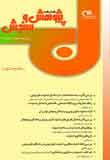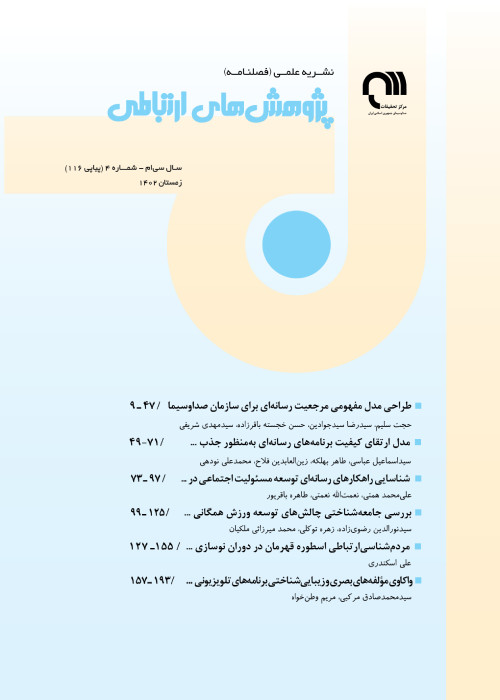فهرست مطالب

فصلنامه پژوهش های ارتباطی
پیاپی 54 (تابستان 1387)
- تاریخ انتشار: 1387/05/11
- تعداد عناوین: 13
-
صفحه 3
-
صفحه 7هدف از تحقیق حاضر، بررسی تاثیر به کارگیری سبک ها یا روش های مداخله در تماشای برنامه های خشونت آمیز تلویزیونی بر میزان پرخاشگری آموخته شده کودکان از این برنامه ها بوده است. به این منظور، 144 پسر 9 تا 11 ساله، با توجه به دو متغیر مهم مداخله گر، یعنی سبک مداخله والدین در تماشای برنامه های تلویزیون و طبقه اجتماعی - اقتصادی در یک طرح آزمایشی عاملی تحت مطالعه قرار گرفتند.
نتایج پژوهش نشان داد هرچند میزان پرخاشگری کلی کودکان در پایان 12 جلسه تماشای کارتون های خشونت آمیز تغییر نکرده است، اعمال روش های آزمایشی مداخله در تماشای کارتون های خشونت آمیز (فعال و محدودکننده) توانسته در میزان تاثیر پذیری کودکان از تماشای این نوع کارتون ها تغییراتی ایجاد کند.
کلیدواژگان: پرخاشگری کودکان، خشونت، رسانه های تصویری، سبک های نظارت -
رابطه رفتار والدین و پایگاه اجتماعی اقتصادی با تماشای خشونت تلویزیونی و تایید و توسل به آن در کودکانصفحه 33مقاله حاضر برگرفته از پژوهشی است که ارتباط بین پایگاه اجتماعی اقتصادی و تماشای خشونت تلویزیونی را با رفتار خشونت آمیز کودکان بررسی می کند و تاثیر رفتار خشونت آمیز والدین را بر توسل کودکان به خشونت مورد مطالعه قرار می دهد.
نتایج به دست آمده نشان می دهد کودکانی که برنامه های خشونت آمیز تلویزیونی را بیشتر تماشا می کنند و کودکانی که در معرض رفتار خشونت آمیز والدین قرار می گیرند، بیشتر از دیگر کودکان به خشونت متوسل می شوند و به تماشای خشونت تلویزیونی تمایل بیشتری دارند.
کلیدواژگان: پایگاه اجتماعی، اقتصادی، جامعه پذیری، خشونت تلویزیونی، پرخاشگری کودکان، رفتار والدین -
صفحه 57هدف از مقاله حاضر، بررسی «اثرات تماشای برنامه های خشونت آمیز تلویزیونی بر پرخاشگری بینندگان» با استفاده از پیشینه و پژوهش های انجام شده، بویژه شناسایی متغیرهای تعدیل کننده و واسطه ای در این زمینه است. نتایج اغلب تحقیقات مؤید آن است که تماشای خشونت تلویزیونی، بویژه در کودکان و نوجوانان منجر به بروز پرخاشگری یا افزایش آن می شود. بدیهی است نیاز جامعه، بخصوص افراد نوجوان و جوان به هیجان و نیز توجه به واقعیت آنچه در اغلب جوامع می گذرد، ارائه تصاویر تلویزیونی عاری از خشونت را دشوار یا حتی غیرممکن می سازد. در این مقاله، تلاش شده است با استفاده از متغیرهای اثرگذار و میانجی، راهکارهایی برای به حداقل رساندن آثار سوء نمایش خشونت در برنامه های تلویزیون، ارائه شود. برخی از این متغیرها عبارتند از: ماهیت مهاجم و قربانی، انگیزه خشونت، وسعت و بی پردگی خشونت، واقع گرایی، پاداش و تنبیه، پیامدها، طنز و.... در پایان راهکارهایی نیز در این زمینه ارائه شده است.
کلیدواژگان: بینندگان، پرخاشگری، تلویزیون، خشونت -
صفحه 81مقاله حاضر برگرفته از پژوهشی است که در سال 1386 در مرکز تحقیقات صداو سیما انجام شده است. این پژوهش با استفاده از طرح شبه آزمایشی پیش آزمون پس آزمون با گروه گواه انجام شده است. آزمودنی ها، 52نفر از نوجوانان پسر کلاس دوم راهنمایی مدرسه جابربن حیان واقع در منطقه پانزده آموزش و پرورش تهران بوده اند. متغیر مستقل پژوهش، نمایش فیلم کارتونی «نجات کودکان» و متغیر وابسته میزان پرخاشگری پس از تماشا بود که در دو نوبت به فاصله دوازده روز سنجیده شده است.
نتایج تحقیق نشان داد که تماشای کارتون خشونت آمیز «نجات کودکان» بر پرخاشگری فیزیکی آزمودنی ها (پس از تماشا) مؤثر واقع شده است؛ به این ترتیب که پرخاشگری فیزیکی آزمودنی ها پس از تماشای کارتون افزایش یافت.
کلیدواژگان: پرخاشگری، کارتون خشونت آمیز، نوجوان -
صفحه 101مقاله حاضر با هدف ارائه پژوهش های جدید (2007) درباره تاثیرات خشونت تلویزیونی نگاشته شده است. در این مقاله پس از تعریف خشونت ساختگی و تمایز میان آن و خشونت واقعی و بیان نظریه های اصلی موجود در مورد تاثیرات نمایش خشونت، به بررسی برخی از پژوهش های صورت گرفته درباره تاثیرات خشونت ساختگی پرداخته شده است. همچنین حوزه پژوهشی جدیدی به نام «قربانی سازی ثانویه»؛ که به حوزه اخلاق رسانه مرتبط است، مطرح شده و مورد تجزیه و تحلیل قرار گرفته است. آنچه جمع بندی نتایج پژوهش های گوناگون نشان می دهد، این است که رسانه در صورتی می تواند سبب عملی خشونت بار شود که زمینه های اجتماعی مناسب با پرخاشگری و خشونت فراهم باشد.
کلیدواژگان: پژوهش، خشونت، خشونت ساختگی، رسانه -
صفحه 121یکی از مهم ترین پدیده های سرگرم کننده در سالیان اخیر، بازی های رایانه ای هستند که با سرعتی روزافزون جای خود را در میان کودکان و نوجوانان باز کرده اند و با بهره گیری از فناوری های نوین، هر روز بیش از پیش با زندگی کاربران عجین شده اند. مهم ترین نکته مورد بحث در مورد این بازی ها، محتوای خشونت آمیز آنهاست که می تواند کاربران را به نحو عمیقی تحت تاثیر قرار دهد و بازتاب های بیرونی ناهنجاری را موجب شود. البته رابطه نمایش خشونت با رفتار افراد به طور قطعی ثابت شده نیست و همین امر باعث شده است، شرکت های سازنده، هر چه بیشتر نسبت به تولید این بازی ها اقدام کنند. از این رو پژوهشگران باید با بررسی میزان تاثیر گذاری این قبیل خشونت ها بر جوانان، پیشنهادهای عملی و قانونی لازم را در این زمینه ارائه دهند. نتایج پژوهش ها می تواند در تولید و ساخت بازی های رایانه ای مؤثر باشد.
کلیدواژگان: بازی های رایانه ای، پرخاشگری، خشونت، رایانه، کودکان، نوجوانان -
صفحه 161
-
صفحه 175
-
صفحه 177
-
صفحه 179
-
صفحه 3
-
Page 7The present article aims at investigating the effects of applying intervening styles or methods in watching TV's violent programs on the level of learned aggression on part of children watching such programs. For the purpose of this study, some 144 boys between 9 to 11 years from one of the Educational Districts in Tehran were selected using randomized cluster sampling. Given the two significant intervening variables, i.e. parents’ intervening style in watching TV programs, and economic-social class, the participants were studied under a factoral experimental plan. The research findings show that although the children's general level of aggression has not changed after watching 12 sessions of violent cartoons, but imposing experimental methods of intervention in watching violent cartoons has eventually changed the impressibility of the children by watching such cartoons.
-
Page 33The present article is based on a research which examines the relationship between social-economic status and exposure to TV violence, and children's violent behaviors. The study also explores the effects of parent's violent behavior on children resorting to violence.The findings show that children with greater exposure to TV violence and those experiencing more violent acts from their parents, are more likely to resort to violence and tend to watch TV violence.
-
Page 57Drawing on the related literature and the bulk of research carried out on TV violence, the present article aims at studying "the effects of TV violent programs on the viewer's violent behaviors." The article identifies moderator and intervening variables in the researches. The results of most of the researches corroborate that watching violence on TV leads to violent behaviors or increases these behaviors especially in children and adolescents. It is obvious that the need of society, particularly adolescents and teenagers, to excitement and considering the reality of what happens in most societies, makes TV programs without violence a rare or even impossible idea. This article tries to present strategies for minimizing the negative impacts of exposing violence on TV using intervening variables. Some of these variables are as follows: the nature of aggressor and victim, the motivation behind the violence, the extent and clarity of the violence, realism, reward and punishment, consequences, satire, etc. The article finally presents some strategies in this regard.
-
Page 81The present article is based on a study carried out in IRIB Research Center in 2007. The research was implemented using the quasi-experimental pretest-posttest control group design.The testees were 52 second graders from Jaber ibn-e-Hayyan high school located at Thehran's Educational District 15. The independent variable in the study was screening a cartoon called "Rescuing Children", and the dependent variable was the violence on part of the students after watching the cartoon. The level of violence was measured two times with the space of twelve days.The findings show that watching the violent cartoon "rescuing children" had effects on the testee's level of physical violence, i.e. the level of violence increased after the students were exposed to the cartoon.
-
Page 101The present article aims at reviewing the recent researches carried out on the effects of TV violence. The paper, first, defines fictional violence and differentiates it from actual violence, then, it states some of the principal theories on the impacts of screening violence. The article further examines some of the researches implemented on the effects of fictional violence. A new research area called as "Secondary victimization" which relates to the ethics of media has also been introduced and analyzed in the article. The summery of the different research findings show that media can only promote violent acts if social grounds are appropriate for violence and aggression.
-
Page 121One of the most important amusing entertainments in recent years is computer games. Computer games are increasingly getting common among children and adolescents. Employing modern technologies, this type of entertainment is becoming more and more rooted in the user's lives. The most significant point regarding these games is their violent contents which can deeply influence on the users and prompt external abnormalities. However, the relationship between screening violence and the individual's behaviors has not been definitively proved yet, and this is why the manufacturing companies are increasingly producing such games. Therefore, researchers should assess the effects of such violence on adolescents, and put forward good practical propositions in this regard. The results of researches on this filed can help producers in producing computer games.
-
Page 139Violence is a widespread dangerous phenomenon at the present time. Given the significant position attached to television as a medium with much audience and multiple potentials, the present article examines the effects of violent TV programs on the American community. The findings show that the excessive violence exposed to individuals, particularly children and adolescents, via TV programs has unpleasant impacts on them. The negative effects include violence-seeking, violent behaviors, desensitivization of children and adults to the violence-related issues, and even cases such as anger, sleep-related disorders. It seems that medium-related violence and actual violence are interrelated in the American society.


